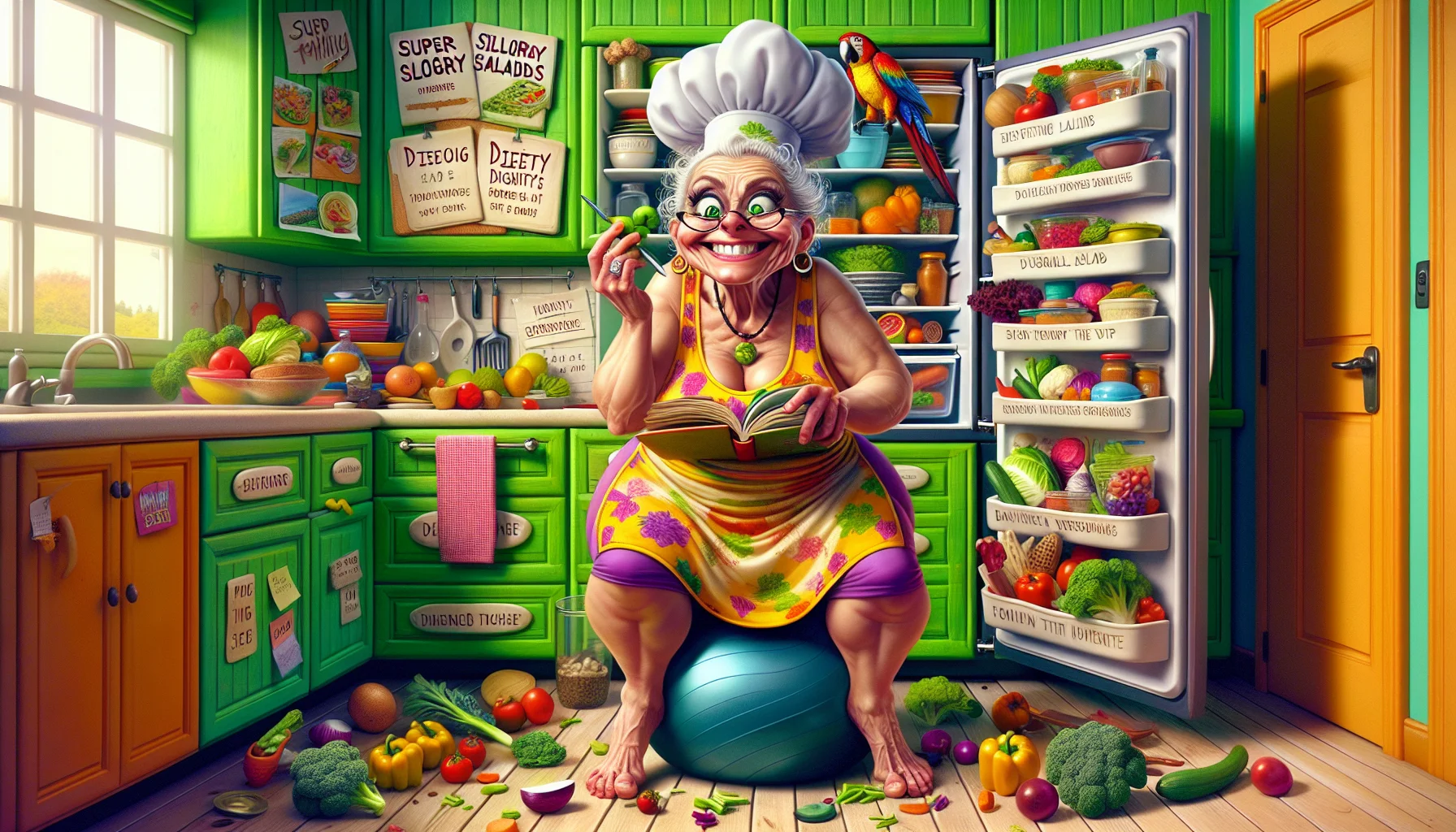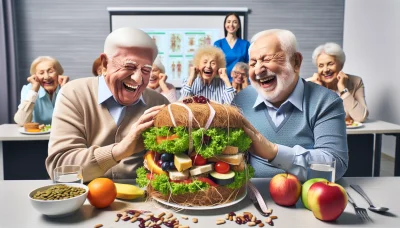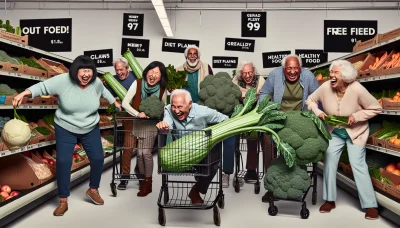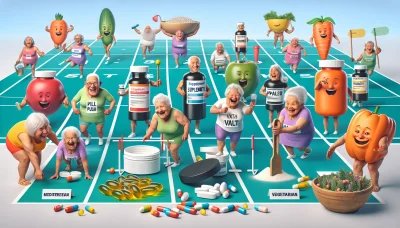Cooking for one person Quiz
Test Your Knowledge
Question of
Essential Cooking Tips for Solo Diners
Mastering Portion Control
Getting portion control right is crucial for solo diners to avoid overeating and wasting food. Start by familiarizing yourself with serving sizes and using smaller plates to help manage portions visually. Investing in a kitchen scale can also aid in measuring out perfect single servings.
When cooking, think in terms of one or two servings max. Stick to recipes that are easy to scale down, and dont be afraid to halve or quarter traditional recipes. This approach not only ensures you're eating fresh meals but also helps in maintaining a balanced diet.
Calculating Nutritional Needs
Solo diners must pay attention to their nutritional intake to ensure they're getting all the necessary vitamins and minerals. Apps and online calculators can help you track your daily needs based on age, gender, and activity level. Remember, your needs are unique, so tailor your diet accordingly.
It's important to include a variety of food groups in your meals. Focus on incorporating lean proteins, whole grains, fruits, and vegetables into each meal. Planning ahead with a weekly menu can help maintain a balanced diet while reducing the stress of last-minute decisions.
Shopping for Single Servings
Grocery shopping for one doesn't have to be challenging. Aim to buy fresh produce in small quantities or from the bulk bins to minimize waste. Many stores offer individually packaged meats, dairy, and other perishables that are ideal for single servings.
Leverage the power of frozen foods for their longevity and conveniencefrozen vegetables, fruits, and even some proteins can be bought in larger quantities without the worry of quick spoilage. They're perfect for throwing together a nutritious meal on the fly.
- Plan before you shop: Make a list to avoid impulse buys.
- Buy versatile ingredients: Choose items that can be used in multiple recipes throughout the week.
- Embrace technology: Use grocery apps for coupons and deals tailored to small households.
- Avoid bulk purchases: Unless it's non-perishable or freezable, buying in bulk often leads to waste.
- Frequent farmer's markets: They're perfect for buying fresh produce in small amounts.
Efficient Meal Preparation
Cooking efficiently is key when dining solo. Opt for recipes that require minimal prep time and cookwarethink one-pot meals or sheet pan dinners. These methods not only save time but also make cleanup a breeze.
Become a master at repurposing leftovers to keep meals interesting and reduce waste. Transform last night's chicken into today's salad topping or wrap filling. Get creative with flavors and textures to make each meal feel new and exciting.
Quick and Easy Recipes
The beauty of solo dining is the freedom to experiment with quick and simple recipes without the pressure of pleasing others. Stock up on staples like eggs, pasta, and canned beans that can be turned into countless speedy dishes with just a few fresh ingredients added.
Dishes like stir-fries, omelets, or grain bowls are not only fast but also infinitely customizable according to what you have on hand. They're perfect canvases for those single servings of proteins and vegetables you've shopped for smartly.
Utilizing Leftovers Creatively
Leftovers should never be boring! Challenge yourself to transform them into entirely new dishes. A roast vegetable from dinner can become part of a savory breakfast hash or blend into a smooth soup for lunch.
Maintain an organized fridge where you can easily see what needs to be used up first. Label your leftovers with dates so you know when they were stored; this will encourage you to use them promptly while they're still at their best quality.
Choosing the Right Diet for One
Understanding Different Diet Types
Embarking on the journey of selecting a diet tailored to your individual needs can be exhilarating. It's crucial to understand that diets are not one-size-fits-all, and what works for one person may not work for another. The key is to match your lifestyle, health goals, and dietary preferences with a compatible eating plan. Doing your homework on various diet types is the first step towards sustainable success.
It's vital to consider nutritional balance when exploring diets. A well-rounded diet should provide all the essential nutrients your body requires. Be wary of fad diets that make grand promises but lack scientific backing. Consulting with healthcare providers or nutritionists can provide insights into how different diets can affect your health, helping you make an informed choice.
Low-Carb and Keto Diets
The low-carb and ketogenic diets are all about reducing carbohydrate intake to force the body into a state of ketosis, where it burns fat for energy. These diets have been linked to weight loss, improved blood sugar control, and other health benefits. However, they require careful planning to ensure you're still getting necessary nutrients.
When considering a low-carb or keto diet, it's essential to focus on high-quality fats and proteins while limiting processed foods. This approach helps maximize the diet's effectiveness while minimizing potential risks. Always remember to listen to your body's signals and adjust accordingly.
Plant-Based and Vegetarian Options
Plant-based and vegetarian diets are gaining popularity due to their potential health benefits and environmental sustainability. These diets focus on whole foods like vegetables, fruits, legumes, nuts, and seeds while eliminating or reducing animal products. They're known for promoting heart health and may reduce the risk of certain chronic diseases.
If you're considering plant-based options, ensure you're getting enough protein, iron, calcium, vitamin B12, and omega-3 fatty acids. These nutrients are crucial for maintaining good health and can sometimes be challenging to obtain from plant sources alone without proper planning.
Personalizing Your Diet Plan
Crafting a personalized diet plan is an empowering step towards achieving your wellness goals. Start by reflecting on what you hope to achievebe it weight loss, enhanced fitness performance, or better overall health. Understanding your motivations will guide you in choosing a diet that aligns with your aspirations.
A successful diet plan is one that fits seamlessly into your daily routine without feeling restrictive or burdensome. Consider food preferences, schedule constraints, and cooking skills when personalizing your plan. This ensures that dietary changes are enjoyable and sustainable long-term.
Setting Realistic Dietary Goals
Realistic goal setting is fundamental when customizing your diet. Ambitious goals might seem inspiring but setting achievable milestones helps maintain motivation and encourages adherence to the diet plan. Remember that progress takes timeit's about consistent small steps rather than drastic overnight changes.
Balancing ambition with practicality leads to lasting dietary changes. Avoid extremes; instead focus on moderation and variety in your food choices. This helps prevent burnout and keeps the journey exciting!
Adapting Recipes to Fit Dietary Restrictions
Adapting recipes allows you to enjoy favorite dishes while sticking to dietary restrictionsa creative challenge that can be both fun and rewarding! Start by swapping out ingredients that don't fit within your chosen diet for healthier alternatives that do.
- Explore Substitutes: Use avocado as a fat source in baking or zucchini noodles in place of pasta.
- Bulk Up with Veggies: Add extra vegetables to dishes for more nutrients and fiber.
- Simplify Sugars: Opt for natural sweeteners like honey or maple syrup over refined sugars.
- Get Creative with Seasonings: Herbs and spices can add flavor without extra calories or carbs.
- Leverage Legumes: Beans and lentils are great protein-packed additions to any meal.
Your palate will adapt over time as you experiment with new flavors and texturesultimately leading to a more diverse and enjoyable meal experience aligned with your dietary goals.
Kitchen Equipment Essentials for Single Cooks
Must-Have Cooking Tools
A chef's knife is the cornerstone of any kitchen, perfect for chopping, slicing, and dicing. A cutting board protects your countertops and aids in food prep. Don't forget a set of mixing bowls; they're indispensable for combining ingredients.
Consider a spatula, a slotted spoon, and tongs as your cooking allies. They'll help you flip, stir, and serve with ease. A reliable frying pan and a saucepan are essential for a variety of dishes from breakfast to dinner.
Multipurpose Appliances
A slow cooker can be your best friend, allowing you to toss in ingredients in the morning and come home to a ready meal. An immersion blender saves space while making soups and smoothies directly in the pot or glass.
For those who love baking and cooking, a stand mixer does it allkneading dough, mixing batter, and even making pasta with the right attachments. On busy days, a rice cooker can cook grains perfectly with minimal effort.
Space-Saving Kitchen Gadgets
Nesting measuring cups and spoons are brilliant for conserving space without sacrificing precision. Look for collapsible colanders that flatten when not in use, freeing up valuable cupboard space.
Magnetic knife strips let you store your knives on the wall safely while keeping them easily accessible. A foldable dish rack can be tucked away after use, ensuring your counter stays clear.
- Opt for multifunctionality: Choose tools that serve multiple purposes to maximize utility and minimize clutter.
- Quality over quantity: Invest in high-quality essentials that will last longer rather than stocking up on gadgets that might break or go unused.
- Size matters: For single cooks, smaller appliances can be more practical and take up less space.
- Magnetic magic: Use magnetic strips or racks to utilize vertical space for storing metal utensils or spice jars.
- Stack smartly: Nesting cookware and bakeware conserve space while keeping everything within reach.
Storing and Organizing Kitchenware
Pegboards offer customizable storage solutions; hang pots, pans, and utensils within arm's reach. Drawer dividers can help keep utensils and gadgets neatly separated and easy to find.
Hanging racks or shelves above your sink or stove can be prime real estate for frequently used items. Use transparent containers to store dry goods; they stack well and let you see what's inside at a glance.
Innovative Storage Solutions
Magnetic spice jars save counter space while adding visual appeal to your kitchen walls. Adjustable cabinet shelves allow you to customize your storage space according to your needs.
An over-the-door organizer isn't just for shoes; it's perfect for storing cleaning supplies, snacks, or small kitchen tools. A rolling cart can serve as extra counter space when needed and tucked away when not in use.
Maintaining a Clutter-Free Cooking Space
A clean countertop is key to an efficient kitchenstore appliances you don't use daily. Regularly declutter by donating or selling tools that no longer serve you or duplicate items you've accumulated over time.
Create a habit of cleaning as you go during food prep; this will keep your workspace orderly and reduce cleanup time later. Embrace vertical storage solutions like wall-mounted racks to free up drawer and counter space.
Shopping Smart: Grocery Tips for Individuals
Budget-Friendly Shopping Strategies
Maximize your savings with budget-friendly shopping strategies that are easy to implement. Start by comparing prices across different stores and brands, and don't forget to check out weekly flyers for sales and discounts. Coupons can be a goldmine for savings, so keep an eye out for digital or paper coupons you can apply to your purchases.
Consider store-brand products as they often provide the same quality as name brands at a fraction of the cost. Loyalty programs are another fantastic way to save; sign up for these programs to earn points or receive members-only discounts. Lastly, avoid shopping when you're hungrystudies show this leads to impulse buys that can quickly inflate your bill.
Buying in Bulk and Repackaging
Bulk buying is a smart move for non-perishable items or products you use frequently. You'll get more for your money and reduce the frequency of shopping trips. However, be cautious not to overbuy perishables that might go bad before you can use themthis negates any savings and leads to waste.
After purchasing in bulk, take the time to repackage food into portion sizes that suit your needs. This step not only helps with meal planning but also extends the shelf life by preventing exposure to air and moisture. Invest in quality storage solutions like airtight containers or vacuum sealers for optimal results.
Seasonal Produce Selection
Embrace the seasonal bounty! Seasonal produce is fresher, tastier, and often cheaper than out-of-season counterparts flown in from afar. Eating seasonally also encourages a varied diet rich in different nutrients throughout the year. Plus, it supports local farmers and reduces your carbon footprint.
To make the most of seasonal produce, stay informed about what's currently in season in your area. Farmers' markets are a great source for fresh, seasonal fruits and vegetables. Don't be afraid to try new varietiesyou might discover a new favorite that's both delicious and economical!
Navigating Grocery Stores Efficiently
- Create a Streamlined Shopping List: Before setting foot in the grocery store, have a clear plan of attack with a well-organized shopping list. This keeps you focused on what you need and reduces time spent wandering aisles.
- Categorize Your List: Organize items by category or store layout (e.g., produce, dairy) to minimize backtracking and expedite your shopping trip.
- Stick to Your List: Avoid impulse purchases by adhering strictly to your listyour wallet will thank you!
- Time Your Visit: Choose less busy times to shop if possible; you'll navigate the store faster without crowds.
- Leverage Technology: Use grocery apps for digital lists that can be sorted automatically and check if items are on sale.
Understanding Food Labels and Expiry Dates
Navigating food labels is crucial for making informed choices about nutrition and avoiding waste due to misunderstanding expiry dates. 'Best before' dates indicate when a product is at its peak quality, but many items are still safe to consume after this date has passeduse your judgment based on appearance and smell.
'Use by' dates are more criticalthey're about safety rather than quality. Consuming products past this date can pose health risks, so adhere strictly to these labels especially on high-risk items like meats and dairy products. Always prioritize consuming items with looming expiry dates first to prevent unnecessary waste.
Meal Planning and Time Management
Crafting a Weekly Meal Plan
Creating a weekly meal plan is a game-changer for busy lives! It streamlines grocery shopping, reduces waste, and alleviates the daily stress of deciding what to eat. Start by picking a day to plan and shop, ensuring you have everything you need for the week ahead.
A well-structured meal plan caters to your dietary needs while keeping your taste buds excited. Use themes like "Meatless Mondays" or "Family Friday Pizzas" to inject fun into your weekly routine. This approach simplifies decision-making and gives everyone something to look forward to!
Balancing Nutrition and Variety
Nutrition should be the cornerstone of any meal plan. Aim for a rainbow of fruits and vegetables to maximize vitamin intake. Incorporate lean proteins, whole grains, and healthy fats to create balanced meals that fuel your body and mind.
Variety is the spice of life, especially when it comes to food! Rotate your proteins and veggies throughout the week. Experiment with different cuisines to keep things interestingtaco night today, Italian tomorrow. Your palate will thank you!
Prepping Ingredients in Advance
Get ahead of the game by prepping ingredients in advance! Dedicate time on the weekend to chop vegetables, marinate proteins, and portion out snacks. This upfront effort pays off during the week when meals come together in no time.
Storage is key when prepping ingredients. Use clear containers to see what's inside easily, label them with dates, and organize your fridge by shelf life. This system keeps things fresh and minimizes food waste.
Time-Saving Cooking Techniques
Efficient cooking methods can slash kitchen time significantly. Embrace techniques that require minimal hands-on attention but deliver maximum flavor. Batch cooking large quantities also means leftovers can become lunches or another dinner in a snap!
Adopting smart kitchen shortcuts without sacrificing quality is crucial. Use pre-cut vegetables or canned legumes when pressed for time. Remember, cooking at home should be enjoyablenot a race against the clock!
One-Pot Meals and Sheet Pan Dinners
- *Enumerative Lists: Used for itemizing elements, events, or tasks, often in a specific order. *Descriptive Lists: Each item is accompanied by additional details or a description. *Checklists: Designed for tracking completion or presence of items or tasks. *Multilevel Lists: Nested lists with items having sub-items. *Matrix Lists: Information presented in a two-dimensional grid or table format. *Priority Lists: Items are organized based on their importance or urgency. *Comparative Lists: Used for juxtaposing two or more items.
Making Use of Pressure Cookers and Slow Cookers
Pressure cookers are modern-day magicians for home chefs! They cook meals at lightning speed while locking in nutrients and flavorsperfect for tender meats and robust stews.
On the flip side, slow cookers are the set-it-and-forget-it heroes of the kitchen. They work wonders on tough cuts of meat and deepen flavors over several hours. Both appliances free up your time so you can focus on other tasksor simply relax.
Overcoming Common Solo Cooking Challenges
Dealing with Cooking Motivation Slumps
It's absolutely normal to hit a motivation slump in the kitchen, especially when you're cooking for one. The key is to recognize that these slumps are temporary. One way to reignite your culinary passion is by setting small, achievable goals. Whether it's trying one new recipe a week or mastering a cooking technique each month, these goals keep your kitchen time exciting!
Don't forget the power of ambiance! Transform your cooking space into an area that inspires joy. Play your favorite music, invest in some fun kitchen gadgets, or simply arrange your space so its more inviting. A delightful environment can make all the difference in boosting your motivation to cook.
Finding Inspiration in New Cuisines
Exploring new cuisines is like taking a gastronomic adventure without leaving home! Dive into cookbooks or online resources to discover dishes from around the world. The vibrant flavors of Thai curries or the comforting warmth of Italian pastas could be just what you need to break out of the routine.
If you're unsure where to start, food blogs and cooking channels are treasure troves of inspiration. They not only offer recipes but also provide valuable insights into the culture behind the dishes, which can deepen your appreciation and excitement for the meals you create.
Joining Cooking Groups or Online Communities
You're not alone! Joining cooking groups or online communities can be incredibly motivating. Sharing successes and failures with like-minded individuals turns the solo cooking experience into a social event, even if it's virtual.
Look for groups that focus on solo cooking tips or meal prep strategies. Engaging with others in this way can introduce you to ideas and techniques you might not have considered before, and it's always more fun to learn together!
Managing Food Waste and Leftovers
Managing food waste is crucial when you're cooking for one. Planning is key buy only what you need and incorporate versatile ingredients that can be used across multiple dishes. Remember, buying in bulk isn't always beneficial for solo cooks.
- Plan Your Meals: Map out your weekly menu to avoid overbuying.
- Shop Smart: Purchase smaller quantities and consider frequent trips to the market for fresh produce.
- Embrace Freezing: Utilize your freezer to extend the shelf-life of ingredients and prepared meals.
- Understand Expiry Dates: Learn the difference between "use-by," "sell-by," and "best before" dates to prevent premature disposal of food.
- Compost: Start composting organic waste to reduce trash output and nourish your garden.
Proper Food Storage Methods
Proper storage extends the life of your ingredients significantly. Invest in quality airtight containers for dry goods and use clear containers for leftovers seeing whats inside may inspire your next meal! And remember, some fruits emit gases that can hasten spoilage; store them separately.
Creative Ways to Repurpose Leftovers
Get creative with leftovers by transforming them into entirely new dishes. That stir-fry from last night? Turn it into a filling for wraps or omelets tomorrow morning. Leftover roasted vegetables can become a hearty soup or puree for sauces with minimal effort.












